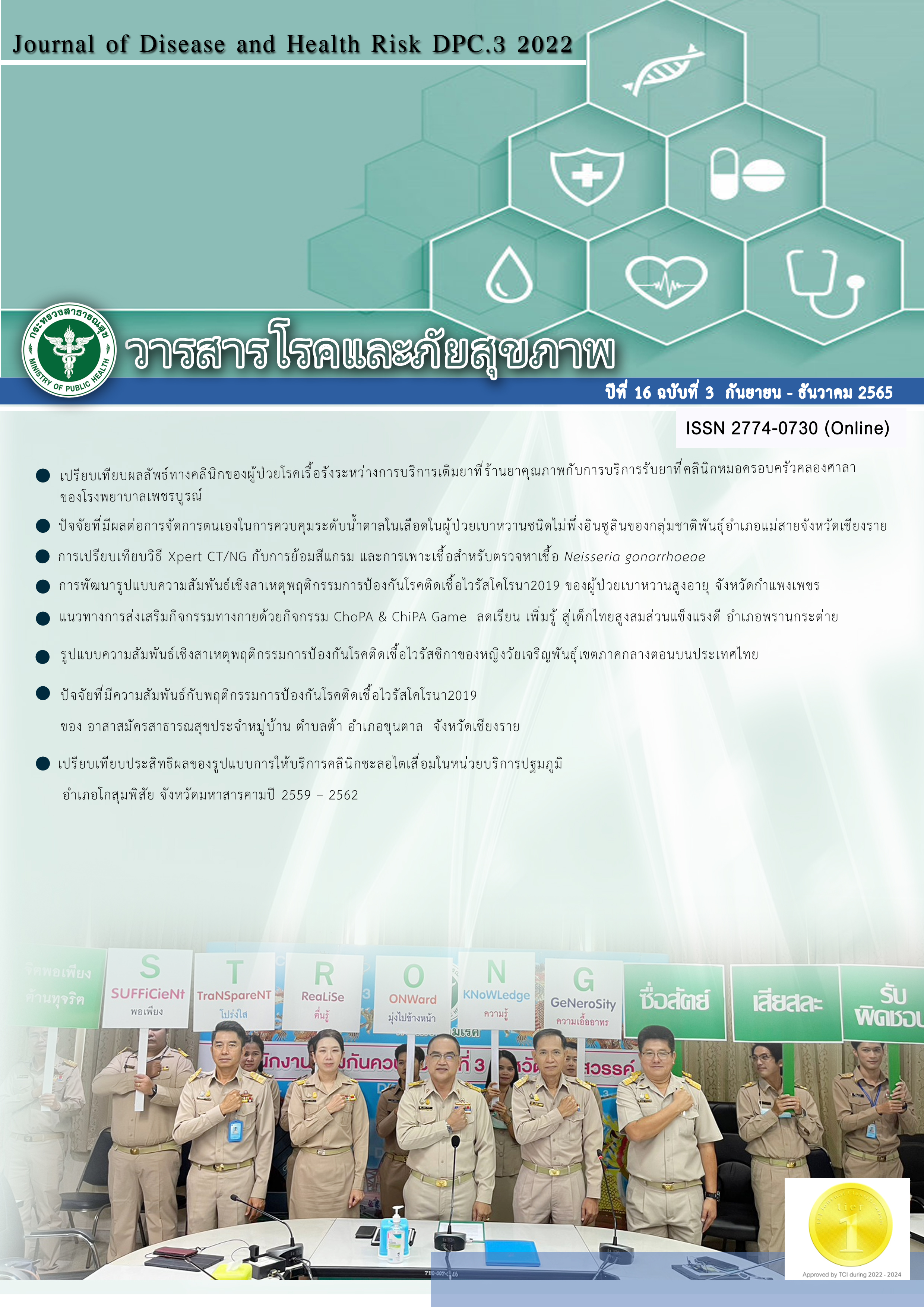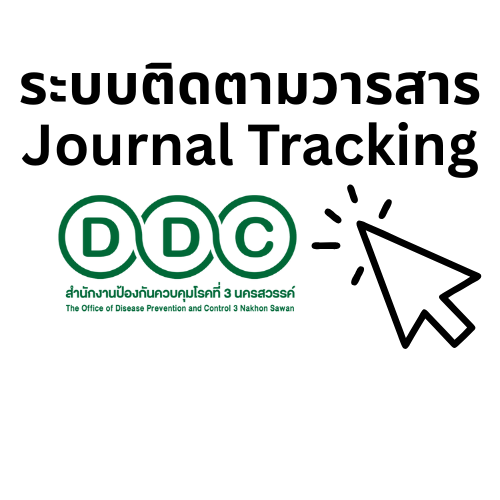Development of Causal Relationship Model of Preventive Behavior on COVID-19 among Diabetes Mellitus Elderly Patients in Kamphaeng Phet Province
Keywords:
Coronavirus Disease 2019, Preventive Behavior, Diabetes Mellitus Elderly PatientsAbstract
The COVID-19 is a new epidemic in the world. There are many cases and deaths, especially in elderly patients. It was found to be an important comorbidity related to the severity of the disease. The objectives of this study were: 1) to identify the factors and components that related to COVID-19 preventive behavior and 2) to develop a model of causal relationship of COVID -19 preventive behavior among diabetes elderly patients. This survey research was a cross-sectional study. A sample of 178 individuals was selected through two-stage random sampling. The data were analyzed using percentages, means, Pearson correlation and structural equation model. The results showed that most of the samples were female, 63.5%, were 60-69 years old, mean The average age was 66.6 years old, Approximated 77.5% had completed educational level at primary school, Almost 82.0% of marital status were married/cohabiting, The average income was less than 5,000 baht per month; 5.3 baht. Around 70.2% of sample were living in local government organizations area and have lived with diabetes for an average of 7.8 years, with at least 1 year and maximum 25 years. Two factors that were associated with COVID -19 preventive behaviors 2019 at medium level were 1) self-management and 2) health literacy. The correlation coefficient (r) at the mean level was 0.30 and 0.44. The causal relationship model of COVID -19 preventive behaviors showed that knowledge, self-management and social support through health literacy had a 40% effect on COVID -19 preventive behaviors, while the Health Belief Model had a 9% effect on negative health literacy. The causal relationship model was able to follow the model explaining the 23% variation, with the model reliably fitting the hypothesized data, Fit (fit) at statistic c2= 86.75, P =0.07, DF = 69 ,CMIN/DF = 1.26, RMR= 0.37, GFI = 0.94, AGFI = 0.90 RMSEA = 0.04. Competent authorities should incorporate the results of this study in their planning and support disease prevention on elderly with diabetes to reduce disease severity.
References
Chen Wang, Peter W Horby, Frederick G Hayden, George F Gao. A novel coronavirus outbreak of global health concern. www.lanect.com Published online January 24, 2022. Available from: https://doi.org/10.1016/S0140-6736(20)30185-9.
กรมควบคุมโรค. สถานการณ์ผู้ติดเชื้อ COVID-19 อัพเดทรายวัน. [อินเทอร์เน็ต]. นนทบุรี: [วันที่อ้างถึง 25 เมษายน 2565]. เข้าถึงได้จาก: https://ddc.moph.go.th/covid19-dashboard/
Bornstein SR, Rubino F, Khunti K, Mingrone G, Hopkins D, Birkenfeld AL, et al. Practical recommendations for the management of diabetes in patients with COVID-19. Lancet Diabetes Endocrinol (8)2020: 546–50 Published Online April 23, 2020 Available from: https://doi.org/10.1016/S2213-8587(20)30152-2
Xue T, Li Q, Zhang Q, Lin W, Wen J, Li Li, et al. Blood glucose levels in elderly subjects with type 2 diabetes during COVID-19 outbreak: a retrospective study in a single center. medRxiv; published online April 2:2020, DOI:10.1101/2020.03.31.20048579 (preprint).
Lacobellis G. COVID-19 and diabetes: can DPP4 inhibition play a role? Diabetes Res Clin Pract; (162)2020: 108125.
Bindom SM, Lazartigues E. The sweeter side of ACE2: physiological evidence for a role in diabetes. Mol Cell Endocrinol, 2009; 302(2):193-202.
Doi: 10.1016/j.mce.2008.09.020. Epub 2008 Oct 1. PMID: 18948167; PMCID: PMC2676688.
กระทรวงสาธารณสุข HDC, กลุ่มรายงานมาตรฐาน. การป่วยด้วยโรคไม่ติดต่อที่สำคัญ. อัตราการป่วยด้วยโรคเบาหวาน สืบค้นจากจาก [อินเทอร์เน็ต]. [เข้าถึงเมื่อ 20 สิงหาคม 2565]. เข้าถึงได้จาก: https://shortest.link/3tJo
Krejcie, R. V. & Morgan, D. W. Determining Sample Size for Research Activities. Educational and Psychological Measurement. 1970. 30(3): 607-10.
Rathmann W, Kuss O, Kostev K. Incidence of newly diagnosed diabetes after Covid-19. Diabetologia. Mar 2022,16;1-6. doi: 10.1007/s00125-022-05670-0. Online ahead of print.
สุรินทร์รัตน์ บัวเร่งเทียนทอง, จันทร์สุดาพรรณ บุญธรรม, จินตนา ฤทธารมย์, ผู้สูงอายุกับพฤติกรรมเนือยนิ่งในสถานการณ์การระบาดโรคติดเชื้อไวรัสโคโรนา 2019. วารสารเกื้อการุณย์ , 2564; 28(2): 154 – 64.
ปิยนุช ปฏิภาณวัตร. ปัจจัยที่มีผลต่อการเสียชีวิตของผู้ป่วยโรคติดเชื้อไวรัสโคโรนา 2019 (COVID-19) โรงพยาบาลกาฬสินธุ์. วารสารสุขภาพและสิ่งแวดล้อมศึกษา.
; 7(1):64 – 71.
Kanfer F H, Gaelick-Buys L. Self-management methods. In F. H. Kanfer & A. Goldstein (Eds.), Helping people change: A textbook of methods (pp.305-360). NewYork: Pergamon Press. 1991.
รินธรรม จารุภาชน์,นงนุช สุรัตนวดี,วิภาพร ต้นภูเขียว,เนตรชนก พันธุ์สุระ,ณัฏฐดา สวนไผ่, อรทัย ปรีดีย์. ความรอบรู้ด้านสุขภาพและระดับพฤติกรรมสุขภาพการป้องกันการติดเชื้อไวรัสโคโรนา 2019 ของผู้ป่วยโรคเบาหวานและความดันโลหิตสูง จังหวัดขอนแก่น.วารสารสำนักงานป้องกันควบคุมโรคที่ 7 ขอนแก่น, 2565; 29(1) :71 – 81.
วิมล โรมา, สายชล คล้อยเอี่ยม. รายงานการสำรวจความรอบรู้ด้านสุขภาพของประชาชนไทย อายุ 15 ปี ขึ้นไป พ.ศ. 2562. นนทบุรี: สถานบันวิจัยระบบสาธารณสุข. 2562.
กิจปพน ศรีธานี. ความสัมพันธ์ระหว่างความฉลาดทางสุขภาพกับคุณภาพชีวิตของ ผู้สูงอายุในภาคตะวันออกเฉียงเหนือตอนกลาง. วารสารวิจัยระบบสาธารณสุข, 2560; 11(1),26-36.
Bronfman N, Repetto P, Cisternas P, Castañeda J. Factors influencing the adoption of COVID-19 preventive behaviors in Chile. Sustainability, 2021; 13, 1-13.
Kojan L, Burbach L, Ziefle M, Valdez AC. Perceptions of behaviour efficacy, not perceptions of threat, are drivers of COVID-19 protective behaviour in Germany. Humanities and Social Sciences Communications, 2022; 9(1): 1-15.
Downloads
Published
How to Cite
Issue
Section
License
Copyright (c) 2022 Journal of Disease and Health Risk DPC.3

This work is licensed under a Creative Commons Attribution-NonCommercial-NoDerivatives 4.0 International License.
Copyright notice
Article published in the Journal of Disease and Health Risk DPC.3 Nakhon Sawan. It is considered a work of academic research and analysis as well as the personal opinion of the author. It is not the opinion of the Office of Disease Prevention and Control 3, Nakhon Sawan. Or the editorial team in any way Authors are responsible for their articles.
Privacy Policy
Name, address and e-mail address specified in the Journal of Disease and Health Risk DPC.3 Nakhon Sawan. It is used for identification purposes of the journal. And will not be used for any other purpose. Or to another person.









